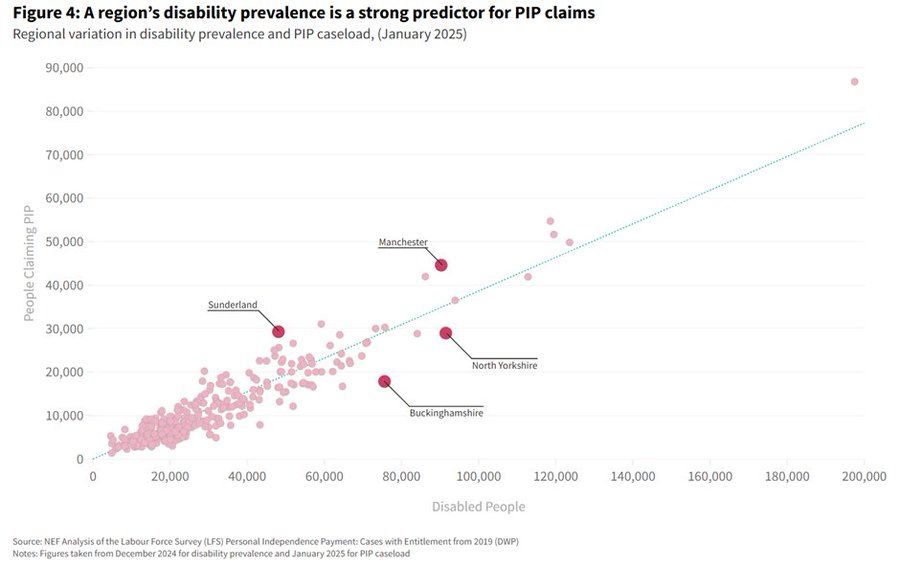
Max Mosley
@maxmosley.bsky.social
Senior Economist at the New Economics Foundation and Labour Councillor for Brentford East
Reposted by Max Mosley
A stark example of this is the government's plan to cut PIP, claiming we "can't afford" the rapid rise in claims. But @maxmosley.bsky.social's analysis shows this rise has been fuelled by growing financial insecurity, which will be further exacerbated by cuts /9 neweconomics.org/2025/05/what...

What’s behind the rise in disability benefit claims?
Rising rates of disability colliding with greater financial hardship are pushing more people to seek support
neweconomics.org
May 15, 2025 at 4:06 PM
A stark example of this is the government's plan to cut PIP, claiming we "can't afford" the rapid rise in claims. But @maxmosley.bsky.social's analysis shows this rise has been fuelled by growing financial insecurity, which will be further exacerbated by cuts /9 neweconomics.org/2025/05/what...
On this basis, it seems unlikely that the proposed tightening of eligibility for PIP will achieve much other than causing further hardship for a group struggling the most since the pandemic.
Link to the full @neweconomics.bsky.social analysis here:
Link to the full @neweconomics.bsky.social analysis here:
May 7, 2025 at 7:51 AM
On this basis, it seems unlikely that the proposed tightening of eligibility for PIP will achieve much other than causing further hardship for a group struggling the most since the pandemic.
Link to the full @neweconomics.bsky.social analysis here:
Link to the full @neweconomics.bsky.social analysis here:
We found that on its own, the number of disabled people explains 71% of the PIP caseload in a particular region. But when we add each region’s relative deprivation using the Index of Multiple Deprivation (IMD) we can explain 94% of the regional PIP caseload
May 7, 2025 at 7:51 AM
We found that on its own, the number of disabled people explains 71% of the PIP caseload in a particular region. But when we add each region’s relative deprivation using the Index of Multiple Deprivation (IMD) we can explain 94% of the regional PIP caseload
But why do places like Buckinghamshire have less PIP claims than we’d expect? Buckinghamshire is a more affluent region so it’s possible that fewer disabled people in the region feel the need to claim disability benefits.
May 7, 2025 at 7:51 AM
But why do places like Buckinghamshire have less PIP claims than we’d expect? Buckinghamshire is a more affluent region so it’s possible that fewer disabled people in the region feel the need to claim disability benefits.
In fact, we found that a regions disability prevalence is a very strong predictor a regions PIP claims, which means the system is targeting the areas it should

May 7, 2025 at 7:51 AM
In fact, we found that a regions disability prevalence is a very strong predictor a regions PIP claims, which means the system is targeting the areas it should
So what’s driving the rise in PIP cases? Despite the concerns that the benefit is not accurately targeting disabled people, we looked across the country and found that actually it is

May 7, 2025 at 7:51 AM
So what’s driving the rise in PIP cases? Despite the concerns that the benefit is not accurately targeting disabled people, we looked across the country and found that actually it is
One other way we can check if PIP claims are for the people it was intended for is by looking at the success rate for people applying for the benefit. If it’s rising this would indicate the system is becoming more lenient.
But we find it’s fairly static
But we find it’s fairly static

May 7, 2025 at 7:51 AM
One other way we can check if PIP claims are for the people it was intended for is by looking at the success rate for people applying for the benefit. If it’s rising this would indicate the system is becoming more lenient.
But we find it’s fairly static
But we find it’s fairly static
But not all disabled people claim benefits - we estimate the take-up is likely under 50%
So while disability claims are rising faster than disability rates, this may simply reflect more disabled people fairly accessing support, not because there’s anything wrong with the system
So while disability claims are rising faster than disability rates, this may simply reflect more disabled people fairly accessing support, not because there’s anything wrong with the system

May 7, 2025 at 7:51 AM
But not all disabled people claim benefits - we estimate the take-up is likely under 50%
So while disability claims are rising faster than disability rates, this may simply reflect more disabled people fairly accessing support, not because there’s anything wrong with the system
So while disability claims are rising faster than disability rates, this may simply reflect more disabled people fairly accessing support, not because there’s anything wrong with the system
A key part of the justification is that the rise in disability benefit claims (34%) is larger than the rise in disability (17%), which could mean the system is now too lenient.
May 7, 2025 at 7:51 AM
A key part of the justification is that the rise in disability benefit claims (34%) is larger than the rise in disability (17%), which could mean the system is now too lenient.


